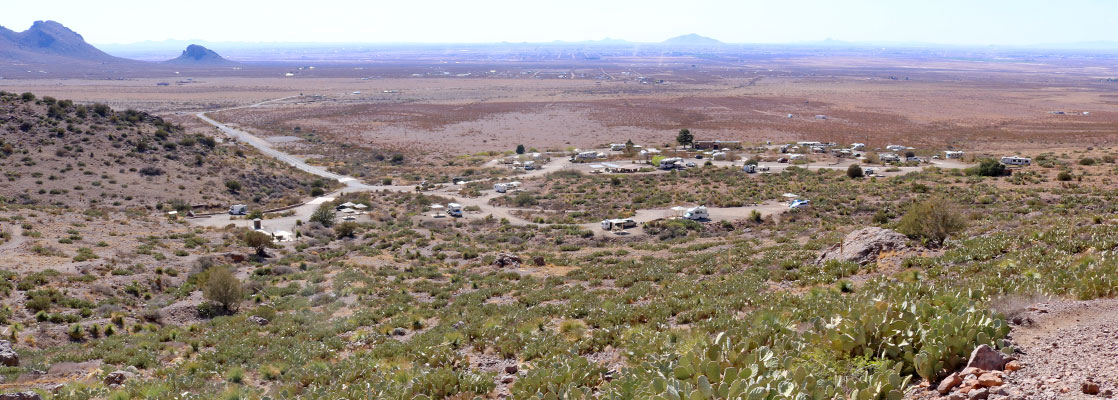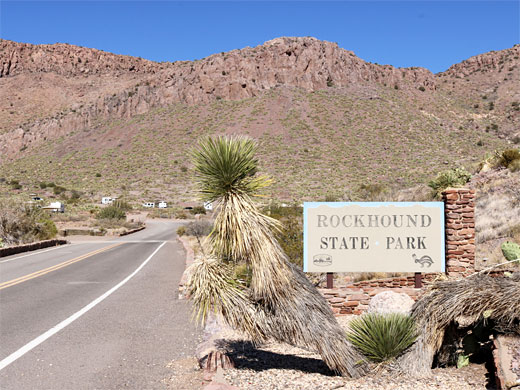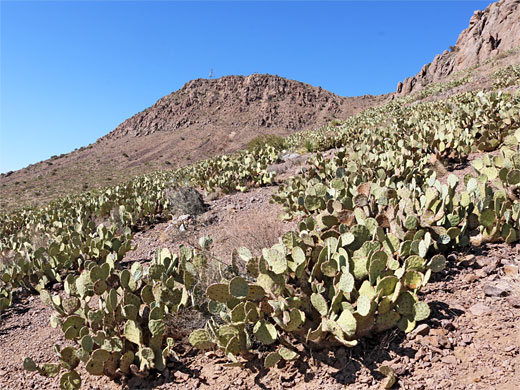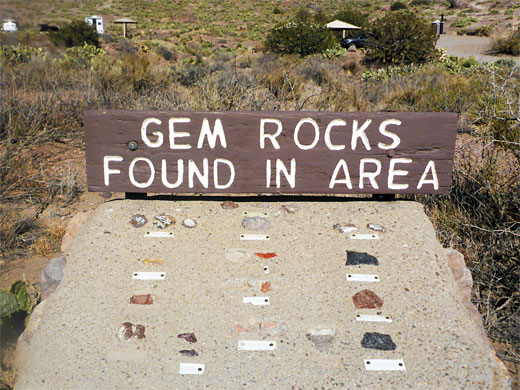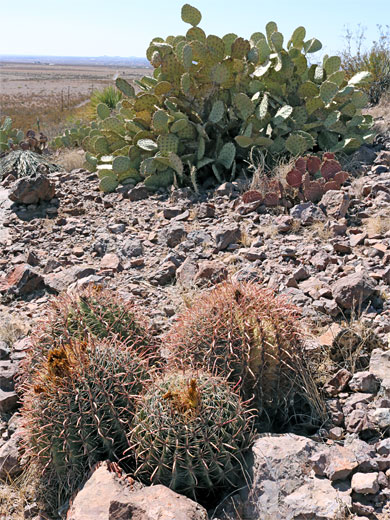Highlights:
Small section of the Little Florida Mountains near Deming where semi precious minerals may be excavated, including jasper and perlite. Park also has a scenic campground, surrounded by the plants of the Chihuahuan Desert, with far reaching views over vast plains to the west
Nearby town:
Deming, 11 miles
Management:
Location:
Seasons:
All year
Rating (1-5):
★★★★★
Weather:
The remote southwest corner of New Mexico, south of I-10, is one of the least-visited parts of the state - there are few roads or villages, just lifeless mountain ranges separated by desert basins, dry lake beds and lava deposits. Several ghost towns are hidden in remote places up in the mountains, relics from mining activity early this century.
Silver and to a lesser extent gold were mined quite extensively, and the geological richness is evidenced by various minerals and semi-precious gems that may be found across the region. One such location is the Little Florida Mountains, 11 miles southeast of Deming which is an easily reached site, close to the interstate.
A small section of the west-facing slopes of the Little Florida Mountains, about one square mile, has been incorporated into Rock Hound State Park, which makes an ideal overnight stop for cross-country travelers, even those not particularly interested in collecting rocks.
Silver and to a lesser extent gold were mined quite extensively, and the geological richness is evidenced by various minerals and semi-precious gems that may be found across the region. One such location is the Little Florida Mountains, 11 miles southeast of Deming which is an easily reached site, close to the interstate.
A small section of the west-facing slopes of the Little Florida Mountains, about one square mile, has been incorporated into Rock Hound State Park, which makes an ideal overnight stop for cross-country travelers, even those not particularly interested in collecting rocks.
Rock Hound Table of Contents
Map of Rock Hound State Park

Photographs
14 views of Rock Hound State Park.
The Park
Rock Hound State Park has a particularly fine campground, with good facilities, spacious sites and commanding views over a large area of flat desert land to the west (full hook-up sites cost $30 in 2025). The place is unusual in that visitors are permitted, even encouraged, to prospect and collect specimens, subject only to a 15 pound weight limit, unlike most national and state parks where removing natural objects is forbidden. Behind the campsite, steep rocky cacti-covered hills rise several hundred feet above the desert, and occasional good mineral specimens are scattered all over the area, but the main location is a shallow ravine towards the south edge of the park. A 1.1 mile loop path (Jasper Trail) runs over the lower slopes from either side of the campground; the ravine is reached by walking a few hundred yards along the south end of the path, then scrambling up the hill a little. The main cactus species in the park are Arizona barrel, Engelmann prickly pear, and Fendler's hedgehog.
Trails
Two trails start at the edge of the Rock Hound campground. The Jasper Trail, 0.7 miles, winds around a low hill to the south, past one of the gem prospecting areas, and ending at the visitor center; walking north along the road makes this a one mile loop. The Thunder Eggs Trail, 0.8 miles, climbs part way up the main slopes of the mountains, giving grand views of the plains to the west. This is also a one mile loop, incorporating part of the campground road. Two further paths, both less used and more strenuous, are 2.5 miles south, in the detached Spring Canyon Unit which occupies part of the Florida Mountains. This unit has its own ranger-monitored entrance, and closes unusually early in the day, at 4:30 pm. The 1.2 mile Lovers' Leap Trail climbs a rocky canyon to a fine viewpoint on a saddle, rising nearly 1000 feet, while the Spring Canyon Trail, 0.5 miles, ascends part of the way up a more enclosed ravine.
Minerals of Rock Hound State Park
Despite the reputation of the park, it is not particularly easy to acquire good mineral specimens. The main mineral that may be collected is jasper (chalcedony), a hard material that occurs in various colours including a red, white, pink and an attractive whitish banded agate form; the jasper is mostly found as small outcrops in solid rock and so requires lengthy chiselling to extract. Geodes, and a similar nodular variety of jasper known as thunder eggs occur in bands of softer rock, but obvious veins have been excavated to a depth of several feet; again some time and effort is necessary. One material easy to find is perlite, a shiny black glassy rock that is exposed at various locations in prominent deposits several feet thick from which it is simple to break off smaller pieces. Generally, prospectors should come equipped with a large hammer, several chisels and a spade, and be prepared to spend several hours on the hillside.
Rock Hound - Nearby Places
- Aguirre Spring Recreation Area (83 miles) - lightly wooded slopes rising to jagged granite peaks, part of the Organ Mountains
- City of Rocks State Park (42 miles) - collection of large, rounded granite boulders
Rock Hound - Similar Places
- Oliver Lee Memorial State Park - popular campground in the foothills of the Sacramento Mountains, with good views west over the wide Tularosa Valley
All Contents © Copyright The American Southwest | Comments and Questions | Contribute | Affiliate Marketing Disclosure | Site Map
